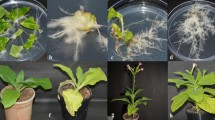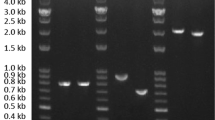Abstract
Squalene epoxidase catalyzes the formation of 2,3-oxidosqualene from squalene and in plants is the last enzyme common to all biosynthetic pathways leading to an array of triterpene derivatives like phytosterols, brassinosteroid phytohormones or saponins. In this work, we present a squalene epoxidase gene (NSSQE1) from the triterpene saponin producing plant Nigella sativa. The gene product showed a high degree of homology to functional squalene epoxidases (SQEs) from Arabidopsis thaliana and was able to complement SQE deficient yeast that harboured a knockout mutation in the underlying erg1 gene. Moreover, the expression of the NSSQE1 gene in ERG1 wild type yeast revealed that NSSQE1 conferred resistance towards terbinafine, an inhibitor of fungal SQEs. The latter suggested that a terbinafine-dependent NSSQE1 selection marker system can be developed for yeast. The gene NSSQE1 was ubiquitously expressed in all plant tissues analysed, including roots where no triterpene saponins are produced. Therefore, we argue that NSSQE1 is a housekeeping gene for triterpene metabolism in Nigella sativa. Similar to triterpene saponins, NSSQE1 was up-regulated by methyl jasmonate in leaves and should also be functionally involved in saponin biosynthesis in Nigella sativa.
Similar content being viewed by others
References
Ghedira K., La nigelle cultivée: Nigella sativa L. (Ranunculaceae), Phytotherapie, 2006, 4, 220–226, (in French)
Ramadan M.F., Nutritional value, functional properties and nutraceutical applications of black cumin (Nigella sativa L.): an overview, Int. J. Food Sci. Technol., 2007, 42, 1208–1218
Kumara S.S.M., Huat B.T.K., Extraction, isolation and characterization of anti-tumor principle, α-Hederin, from the seeds of Nigella sativa, Planta Med., 2001, 67, 29–32
Tian Z., Liu Y.-M., Chen S.-B., Yang J.-S., Xiao P.-G., Wang L., et al., Cytotoxicity of two triterpenoids from Nigella glandulifera, Molecules, 2006, 11, 693–699
Scholz M., Lipinski M., Luftmann H., Leupold M., Ofir R., Fischer, R. et al., Methyl jasmonate induced accumulation of kalopanaxsaponin I in Nigella sativa, Phytochemistry, 2009, accepted for publication
Hostettmann K., Marston A., Saponins, Chemistry and Pharmacology of Natural Products, Cambridge University Press, Cambridge, 1995
Lichtenthaler H.K., The 1-deoxy-D-xylulose-5-phosphate pathway of isoprenoid biosynthesis in plants, Annu. Rev. Plant. Physiol. Plant. Mol. Biol., 1999, 50, 322–328
Phillips D.R., Rasbery J.M., Bartel B., Matsuda S.P.T., Biosynthetic diversity in plant triterpene cyclization, Curr. Opin. Plant Biol., 2006, 9, 305–314
Xu R., Fazio G.C., Matsuda S.P.T., On the origin of triterpenoid skeletal diversity, Phytochemistry, 2004, 65, 261–291
Busquets A., Keim V., Closa M., del Arco A., Boronat A., Arró M., et al., Arabidopsis thaliana contains a single gene encoding squalene synthase, Plant. Mol. Biol., 2008, 67, 25–36
Rasbery J.M., Shan H., LeClair R.J., Norman M., Matsuda S.P.T., Bartel B., Arabidopsis thaliana squalene epoxidase 1 is essential for root and seed development, J. Biol. Chem., 2007, 282, 17002–17013
Colicelli J., Birchmeier C., Michaeli T., O’Neill K., Riggs M., Wigler M., Isolation and characterization of a mammalian gene encoding a high-affinity cAMP phosphodiesterase, Proc. Natl. Acad. Sci. USA., 1989, 86, 3599–3603
Gietz R.D., Woods R.A., Transformation of yeast by lithium acetate/single-stranded carrier DNA/polyethylene glycol method, Meth. Enzymol., 2002, 350, 87–96
Landl K.M., Klösch B., Turnowsky F., ERG1, encoding squalene epoxidase, is located on the right arm of chromosome VII of Saccharomyces cerevisiae, Yeast, 1996, 12, 609–613
Ruckenstuhl C., Eidenberger A., Lang S., Turnowsky F., Single amino acid exchanges in FAD-binding domains of squalene epoxidase of Saccharomyces cerevisiae lead to either loss of functionality or terbinafine sensitivity, Biochem. Soc. Trans., 2005, 33, 1197–1201
Suzuki H., Achnine L., Xu R., Matsuda S.P.T., Dixon R.A., A genomics approach to the early stages of triterpene saponin biosynthesis in Medicago truncatula, Plant J., 2002, 32, 1033–1048
Ruckenstuhl C., Lang S., Poschenel A., Eidenberger A., Baral P.K., Kohút P., et al., Characterization of squalene epoxidase of Saccharomyces cerevisiae by applying terbinafine-sensitive variants, Antimicrob. Agents Chemother., 2007, 51, 275–284
Author information
Authors and Affiliations
Corresponding author
About this article
Cite this article
Lipinski, M., Scholz, M., Pieper, K. et al. A squalene epoxidase from Nigella sativa participates in saponin biosynthesis and mediates terbinafine resistance in yeast. cent.eur.j.biol. 4, 163–169 (2009). https://doi.org/10.2478/s11535-009-0002-8
Received:
Accepted:
Published:
Issue Date:
DOI: https://doi.org/10.2478/s11535-009-0002-8




